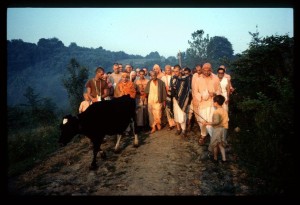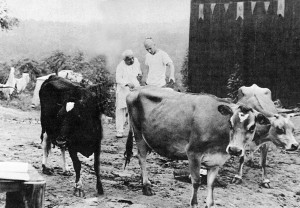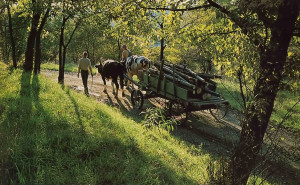By Madhava Smullen

Gaura Saksi das expresses his gratitude for Jaya Murari das.
“People aren’t showing up with prepared speeches just yet,” jokes Chaitanya Mangala, MC of New Vrindaban’s fourth service appreciation ceremony since 2014. “But you can tell that what they’re sharing is much more thought-out.”
His quip illuminates just how much the ceremony has grown to mean to New Vrindaban residents, who are taking to heart Lord Krishna’s assertion, “I consider worship of My devotees to be better than direct worship of Me.”
At each ceremony, people are taking more time to think about and express their appreciations of their fellow devotees. They’re also digging deeper – while previously one or two would become misty-eyed, this spring’s ceremony on April 17th saw at least a dozen devotees deliver such heartfelt tributes that they were choked up with tears and had to pause for a few moments.
Preceding the open appreciations were Chaitanya Mangala’s Powerpoint presentations about each person’s life and service, beginning with Betty Hickey, retired caretaker of the Rose Garden at Prabhupada’s Palace – who was present with her son Glenn.

Vraja Johnson awards Betty Hickey her service appreciation plaque on April 17th.
Betty, who comes from a neighboring family of farmers, started at the Bahulaban greenhouse in 1983, moved to the Rose Garden in 1985, and managed it for most of her nearly thirty years of service until her retirement in 2011.
During that time she carefully cultivated it into an award-winning rose garden, named several times between 1988 and 1998 as one of the top 100 gardens in the United States by the American Rose Society.
Constantly making newspaper headlines, the Palace Rose Garden drew rose aficionados to New Vrindaban in droves. Also serving as the tour guide, Betty led them around, dazzling them with her botanical knowledge.
After the presentation, devotees praised Betty’s care, dedication, and kind-heartedness. Those who had worked with her in the Rose Garden over the years were grateful for her gentle, encouraging corrections when things weren’t up to standard, and for making them feel so valuable.
Betty’s late husband Jim Hickey, who passed away in December 2006, was also honored for his service. Jim worked as the head maintenance man at New Vrindaban during the 1980s, and was well-remembered for driving his blue flat-bed pick-up truck up and down the ridge, taking care of many things that needed repairing.
Like all the appreciation recipients throughout the evening, Betty was presented with a plaque by the ISKCON New Vrindaban and Eco-Vrindaban boards, commemorating her and Jim’s contribution.
“I think that it’s not work if it’s good work, and I always enjoyed my work here,” she commented, calling the devotees gathered “some of my best friends.”
Next, Jaya Murari Das was honored for his more than four decades of service. Joining ISKCON in the spring of 1975, he moved to New Vrindaban that November, and received initiation from Srila Prabhupada on July 29th, 1976.
For the early residents, Jaya Murari’s appearance in New Vrindaban was nothing short of heaven-sent. At the time, the backwoods community was extremely austere, with only one faucet, no proper toilets or plumbing, and widespread dysentery from the contaminated water.

Jaya Murari 2016 portrait.
Jaya Murari, about ten years older than most of the other devotees and already well into a career as a master plumber, turned up with four truckloads of tools and plumbing materials. He soon built a safe and reliable plumbing infrastructure for the community, which he continued to expand and improve upon over the years until his retirement in the 2000s.
Always a dependable presence, he is also well-known for his photography and for his delicious Sunday pancake breakfasts in the early days.
Although Jaya Murari couldn’t attend the ceremony due to ill-health, the many devotees who rose to share their appreciations were filmed for him. Tears flowed freely as they recalled how completely he had changed the New Vrindaban experience; how he exemplified the gentle brahminical nature Prabhupada described in his books; and how he was a “Prabhupada man” through and through.

Ananga Manjari awards Sukhavaha dasi her service appreciation plaque.
Next to be honored was devotee care manager Sukhavaha Dasi. After she joined in 1974 and was initiated by Prabhupada in 1975, she began helping the Pittsburgh and New Vrindaban temples with their bookkeeping. She was then put in charge of New Vrindaban’s “red trailer store,” distributing all the supplies devotees needed for their health and services.
In 1976, New Vrindaban installed industrial washing machines, and Sukhavaha headed up the laundry department; while in the 1980s, she spent much of her time on the road, fundraising. During this phase, she had her son Bhagavan, and daughters Sukadevi and Narahari.
More recently, she started ISKCON New Vrindaban’s devotee care program, and will be turning the “Prabhupada House” near the temple into a Wellness Center that will provide many physical, emotional and mental health services.
Offering appreciation, the devotees gathered described her as full of enthusiasm, always there to help, and very dedicated to working on herself. The greatest example of the latter was expressed in a very moving moment when her son Bhagavan, who was present, spoke about his mother. Like a lot of ISKCON parents in the early days, he said, she had focused on her services to the detriment of caring for her children.
“But a decade ago, you called me up one night, and said you wanted to talk about the past, and take responsibility for it,” Bhagavan recalled. “And since then, we’ve worked through many of our issues, and I couldn’t be happier with our relationship today.”

Bhima Walker awards Sarva Saksi and Viduttama dasi their service appreciation plaque.
Finally, husband and wife Sarvasaksi Das and Viduttama Dasi were honored for their life of service. Joining ISKCON in 1974 as a married couple and moving to New Vrindaban that same year, they were initiated by Srila Prabhupada on Janmastami 1975.
Both did early services connected to the cows, which were a central part of New Vrindaban life at the time, with about 100 cows to 150 people.
Sarva helped milk all the cows by hand and herded them in and out of the Bahulaban pastures daily. Viduttama churned cream into butter for the Deities and devotees, also by hand. Both were photographed and featured in a 1976 Back to Godhead magazine article.
Later, as construction began on Prabhupada’s Palace, Sarva worked with the heavy equipment department. He then spent a decade as a silversmith, casting and making jewelry for a local New Vrindaban business. He is now semi-retired.
Viduttama, meanwhile, did the laundry in the days before washing machines came to New Vrindaban, washing everyone’s clothes by hand, outside, with cold water, rocks and ashes. Next, she worked in the Palace gift shop, where she enjoyed meeting and interacting with guests. She and Sarva also had two children – a son, Sudarshan, and a daughter, Radhastami.
Last year, Viduttama came full circle, as she began working for Govinda’s Groceries gift store and doing laundry for the Palace Lodge — the exact same services she did all those years ago. “And I love it!” she blurted out at the ceremony. “I couldn’t be any happier!”
A whole host of devotees recalled their many fond memories of serving with Sarva and Viduttama, as well as their kindness, devotion, down-to-earth natures and enthusiasm. The outpouring of love moved the couple to tears.

Ekadasi cake made by Lakshmanesvara das.
According to Srila Prabhupada’s purport in Verse 4 of the Nectar of Instruction, MC Chaitanya Mangala pointed out, these kinds of loving exchanges between devotees were exactly what ISKCON had been established to facilitate.
In conclusion he also quoted a 1972 lecture by Prabhupada in which he said, “In the lower stage, a devotee is concerned with the Deity worship, but he does not take much care of the devotees. But when one is advanced further, he can see Krsna and His devotees also.”
“Clearly, in the early days of ISKCON, we were at that lower stage,” Chaitanya Mangala says. “Now, let’s collectively evolve to the next level, where we worship Krishna in the temple, and also care for the devotees around us.”
That care continued to be shown into the evening, as devotees drank herbal tea, tucked into a celebratory Ekadasi cake made by Laksman Isvara Das, and chatted, furthering the loving connections made throughout the ceremony.








































































































